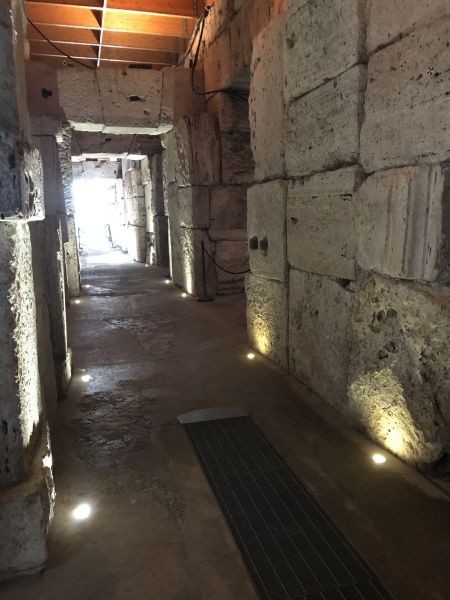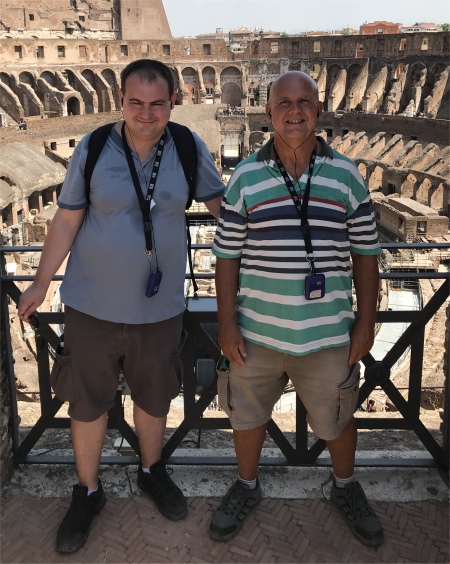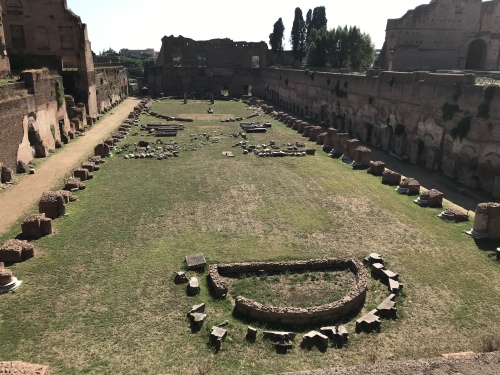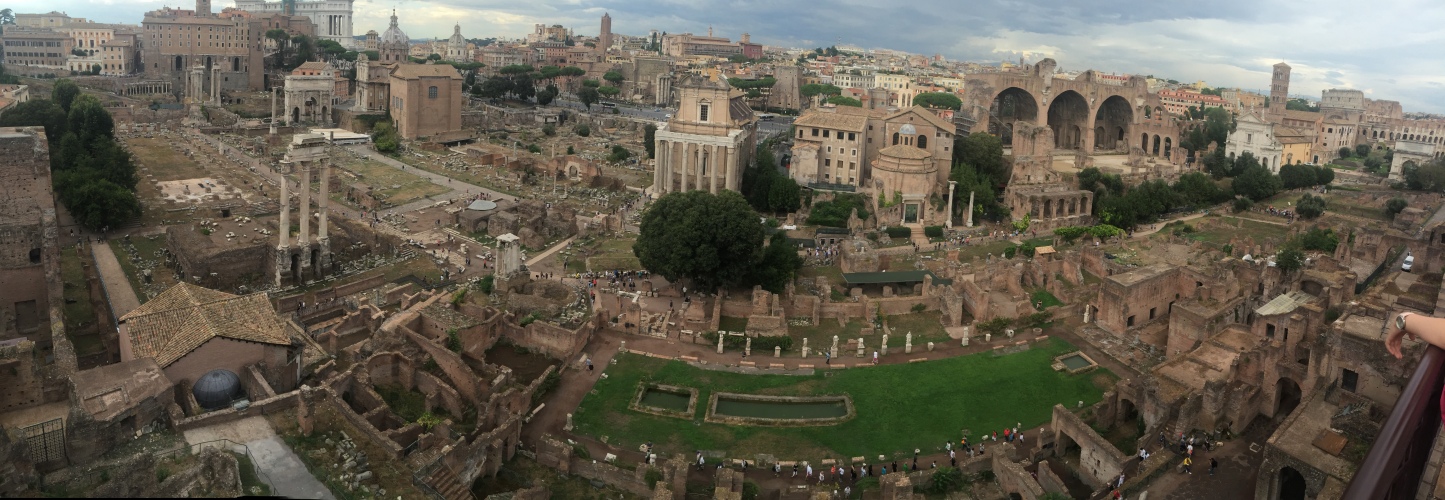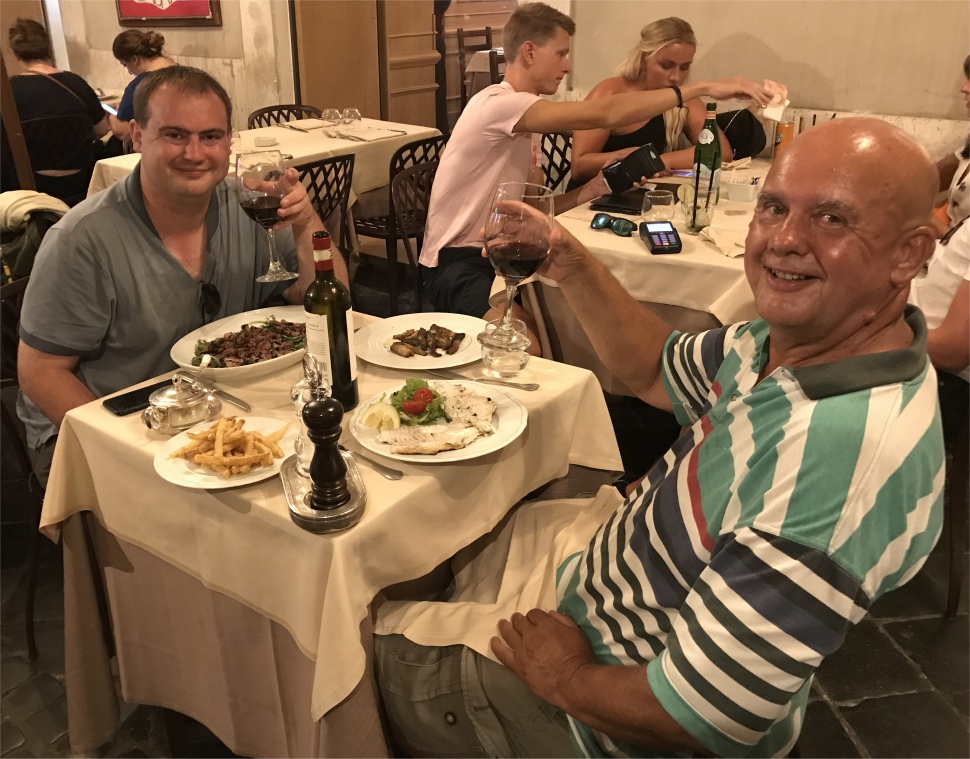
Arch of Titus
|
Paul led us down a series of steps to the Roman Forum, and we paused a while at the highest point of the Sacra Via, the Summa Sacra Via, where the Arch of Titus was located. The Arch of Titus commands a key point along the triumphal route (via Triumphalis), one that visually links the valley of the Flavian amphitheatre (Colosseum) to the valley of the Forum Romanum and the Capitoline Hill beyond. Many triumphal parades had passed along this route for many centuries, thus the choice to place a permanent triumphal monument astride the route was not accidental but, rather, deliberately evocative of the fact that the triumph as a ritual both created and reinforced collective memory for Romans. The arch was erected by Domitian in c. 81AD. It commemorates the victories of his father Vespasian and brother Titus in the Jewish War in Judaea (70-71AD) when the great city of Jerusalem was sacked and the vast riches of its temple plundered. The arch is also a political and religious statement expressing the divinity of the late emperor Titus.
We walked along the Sacra Via, and as we passed the Tempio di Antonio e Faustina, Paul paused, pointing to a patch of land just opposite the temple, with remains of a building, the Regia. The Regia was not labelled in any way, but Paul took delight in informing us about it. The Regia was a two-part structure in Ancient Rome lying along the Sacra Via at the edge of the Roman Forum that originally served as the residence or one of the main headquarters of kings of Rome and later as the office of the Pontifex Maximus, the highest religious official of Rome. It occupied a triangular patch of terrain between the Temple of Vesta, the Temple of Divus Julius and Temple of Antoninus and Faustina. Only the foundations of Republican/Imperial Regia remain.
According to ancient tradition it was built by the second king of Rome, Numa Pompilius, as a royal palace. Indeed, the Latin term "regia" can be translated as royal residence. It is said that he also built the Temple of Vesta and the House of the Vestal Virgins as well as the Domus Publica. This created a central area for political and religious life in the city and Kingdom. When Caesar became Pontifex Maximus, he exercised his duties from the Regia. Paul regretted missing out on a dig that took place there.
Nearby, at the point in the Forum, where the ground begins to rise towards the slopes of the Palatine, there stood a temple that was of the utmost importance for the city and her population, for it was dedicated to the goddess who was protectoress of the family and thus also of the State: the Temple of Vesta, traditionally attributed to Numa Pompilius, one of the first kings of Rome.
Stored away in the innermost shrine of this temple and equally jealously guarded, the city also preserved numerous sacred objects, including the Palladium, the wooden image of Pallas Athena, that, as legend would have it, Aeneas had brought from Troy as pledge and warranty of empire. This ancient temple was built in imitation of a primitive round hut, its hearth fire symbolizing the perpetuity of the Roman State. It was not a true temple in that its space was not inaugurated, nor did it contain an image of Vesta, the goddess of the household hearth.

Regia
|
The House of the Vestal Virgins, which rose immediately adjacent to the Temple of Vesta, was the home and official residence of the priestesses charged with guarding the sacred and eternal flame, symbol of the eternal life of the city, that burned in the temple and performing the rites connected with the cult of the hearth. The House, which has been considered as the prototype of present-day monastic convents, was organized around a large courtyard kept as a garden and surrounded on all sides by a portico.
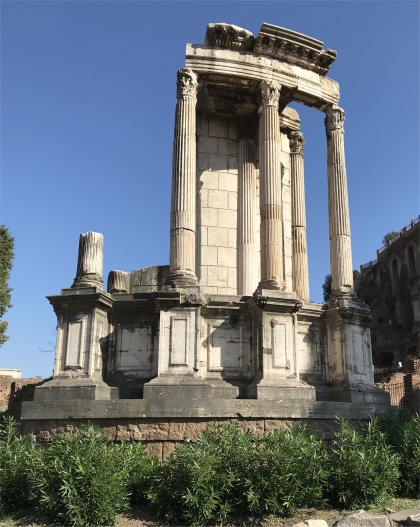
Temple of Vesta
|
The Vestal Virgins were six in number; they entered as novices between the age of six and ten, and remained for thirty years under vows of strict chastity. They were chosen by the supreme religious authority of the State, the Pontifex Maximus; at first only Patricians were eligible, but later they could be chosen also from among the Plebeian families.
We had now descended into the Central Piazza, down-town of Ancient Rome. This was the most crowded and certainly the most preferred spot to do business of all kinds. The Roman Forum was for centuries the centre of Rome's public life. All important social and political events took place here, from elections to public speeches, from triumphal processions to criminal trials, from gladiatorial matches to commercial affairs. Known by the citizens of the time as the Forum Magnum, or simply the Forum (meaning piazza, square), it remained the heart of Rome from the 8th century BC to the 7th century AD.
Prisoners were given to the Legionnaires as war booty and were then sold to slave merchants. They were exhibited on a small stage in the piazza with plaques on their chests that stated any qualities or defects of the unfortunate soul. Often they were destined to do heavy work in the fields but those who had been educated ended up in the homes of rich patricians. Those slaves who were able to read, write or do arithmetic could be worth a fortune: they were, in fact, used as educators for the children of Roman nobility and could command prices as high as half a million Sestertii. The owners, at some point, could give them the gift of their freedom, allowing them to become "Liberti". This condition guaranteed their complete entrance into public Roman life and they could then choose to become government employees, merchants or even take up a military career.
A row of large columns used to be in this spot to honour very important people. Today only one is still standing, that dedicated to the emperor Foca. He was a Bizantine emperor and probably would have remained unknown had the column not been set up in his honour because of his gift of the Pantheon to the pope. This column is truly a symbol because it was the last monument erected in the Roman Forum, in 608 AD, when the Medieval period had already begun.
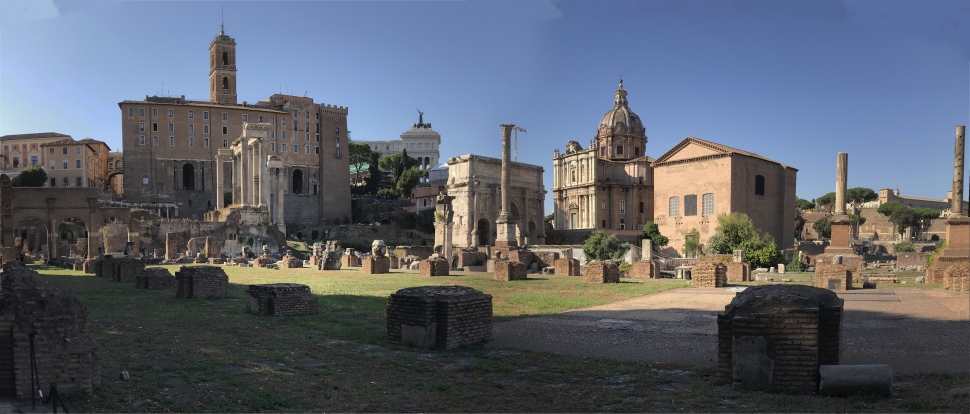
Central Piazza. From the Left: Tabularium, Temple of Saturn, Arch of Septimus Severus, and Curia Julia - Senate
|
On the front slope of the Capitoline Hill is the Tabularium, the repository for official state archives. The large building, which also housed the offices of many city officials, dates to 78BC when the building was completed by Quintus Lutatius Catulus. From the 67m-long corridor, which is still partly preserved, the arched windows look out over the Forum. The tower was added in the 1300s, while the upper and western parts were demolished by Michelangelo to work on the design of the Palazzo Senatorio, built atop the Tabularium in the 12th century.
The 4th century AD Temple of Saturn is situated in the north west corner of the Roman Forum and has eight majestic columns still standing. Built in honour of Saturn, it was the focal point of this ancient cult and stood on the site of the original temple dedicated in c. 497BC, which itself had replaced the god's first shrine, the Ara Saturni. In addition, during the Republic the temple also housed the public treasury (aerarium), a function it kept, albeit in a more limited function, in the Imperial period.
Close to the foot of the Capitoline Hill is the Triumphal Arch of Septimius Severus, built in 203AD to commemorate the victories of emperor Septimius Severus and his two sons, Caracalla and Geta, in the wars against the Parthians. Built in brick and travertine, clad with marble slabs, it is a three-way triumphal arch, measuring almost 21m in height and 23m in width.
When a Roman general had killed at least 5,000 enemies and conquered new territories, he could then enter victoriously into the city, dressed in his armour. He would pass along the Via Sacra, under the triumphal arches, until he reached the Temple of Jove on Capitoline Hill. There was no better place in Rome than the Forum to celebrate its victories. The processions were majestic, rich in colour and sound and involved the whole population: it was the best way to show the world Rome's power. High level politicians opened the ceremonies, followed by actors doing scenes from the battles.
The show was enriched with music and dance. The spoils of war were triumphantly exhibited so that every citizen could admire the treasures taken from the enemy: arms, jewels, works of art, even exotic animals, not to mention the prisoners trudging along in chains. Only then, towards the end of the procession, standing on a golden chariot pulled by four white horses, came the victorious warrior, acclaimed by the riotous crowd that made way for his passage. Finally, the soldiers who had participated in the war, yelling and singing, happy for their victory and most of all, for the pay they had just received. The procession ended on the Capitoline Hill, at the Temple of Jove, with a sacrifice to thank the gods. Sometimes the sacrifice was the killing of the head of the enemy army: the loser, humiliated, was killed without pity in front of the authorities and all the people.
When the emperor Septimius Severus died, Caracalla didn't want to share imperial power with his brother and so decided to grab the throne with the classic technique of "homicide". Caracalla went down in history as one of Rome's cruellest emperors.
Paul pointed out a large, somewhat anonymous-looking brick building facing the piazza, the Curia Julia. It was the official meeting place of the Roman Senate. After voting, senators would come out of the building and share their decisions with citizens gathered in the Forum. Construction began in 44BC under Julius Caesar, but was interrupted following Caesar's assassination. It was finished by his successor, Augustus, in 29BC. The Curia Julia has been well preserved thanks to its conversion into the basilica of Sant'Adriano al Foro in the 7th century.
The Senate was the primary governing body and represented the wisdom and power of Rome. Rome's future was decided here, decisions were made that had repercussions for the entire Empire, even for places thousands of miles away. It held more than 300 senators that sat along the steps at the sides of the hall and at the centre there was the presidential podium. The senators all wore their characteristic white toga, bordered with red, and so long that it was worn folded and laid over the left arm. All Roman citizens could wear the toga but usually they wore it only for religious holidays or particular ceremonies; senators, on the other hand, wore it as a badge of distinction.
Only men of a certain prestige and great experience could be senators. In fact, the word "senator" comes from the Latin "senex" - old. Of course, there were some exceptions, as in the case of the emperor Caligula who, according to legend, had his horse made senator! Obviously this was a bit of a provocation to express his total disdain for the Senate and to show that even an animal could improve its decisions.
On the eastern side of the Central Piazza stood the Temple of Castor and Pollux or the "Dioscuri", with only three columns surviving. They recall one of the first legendary victories of the Romans over the Latins. This was a temple dedicated to the dioscouri Castor and Pollux, who had helped the Romans win a battle against the Latins in 496BC. As the legend tells it, the two men were seen watering their horses at a spring in the Forum Romanum after the battle. A temple was built at this location by Roman dictator Aulus Postumius Albinus, and it was completed in 484BC. The temple went through several restorations in 117BC. It was enlarged by L. Cecilius Dalmaticus to celebrate victory over the Dalmations, Gaius Verres restored it in 73BC, and Tiberius restored the temple in 106AD after a fire had destroyed it in 14BC.
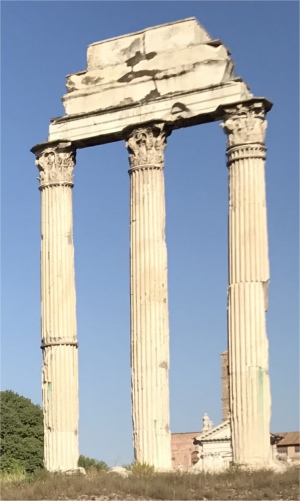
Temple of Castor and Pollux
|
Close by to the Temple of Castor and Pollux stood a small innocuous building. It was here where Julius Caesar's body was cremated, and his adopted son Augustus ordered built first an altar then a temple to pay homage to his father, honouring him as a divinity.
Julius Caesar had certainly made many enemies. In 44BC, the news of his assassination had a devastating effect on Rome. The authors of the assassination plot fled the city while in this exact spot at the center of the Forum, the people, profoundly moved, dedicated to him this final honour. Today, little remains of the Temple of the Divine Julius due to the removal of precious stone over the centuries that followed. You can still make out the semi-circular shape and some of the altar. Thanks to the images on certain Roman coins, we know that it must have been quite imposing, with a high stairway and 6 marble columns on the facade.
In the stifling heat we retraced our steps along the Sacra Via, passing the well preserved Temple of Antoninus and Faustina on the way. The building stands on a tall plinth preceded by a flight of brick steps, rebuilt in modern times, which has incorporated the ancient core, also made of brick. In the 7th and 8th centuries it was converted into the Church of San Lorenzo in Miranda, which incorporated the remains of the original temple.
The temple built by Antoninus Pius in honour of his deified wife, the empress Faustina, who died in 141AD. After the death of Antoninus himself in 161AD, the temple was dedicated to both together. The inscription on the architrave records the first dedication, and that added afterwards on the frieze records the second. In consequence of this double dedication the proper name of the temple became the Temple of Antoninus and Faustina.

Temple of Antoninus and Faustina
|
The temple was the seat of the College of Priests (called Pontifices), who met under the presidency of the Pontifex Maximus, the chief religious authority of the Roman State. Here were drawn up the calendar and the official lists of consuls and of the holders of triumphs; here the rules were fixed that governed sacrifices at altars and temples, and here were decreed the punishments for crimes against religion. All of these activities were recorded in written form in the famous Books of the Pontifices.
Paul spent a while explaining how he saw the Roman expansionist policy. The ancient Romans cast a long shadow over the peoples of Europe. Even the vocabulary of modern European expansion is Roman: The words imperialism, empire, colonialism, colony, proconsul, and procurator all come from Rome. In addition, Roman approaches towards acquisition and administration of conquered territory and individuals provided the foundation, the blueprint, for later European expansion and rule.
The Romans were unique among ancient peoples in that they willingly and freely incorporated newly conquered people into their own society, freely giving citizenship to outsiders in order to Romanise them and make them willing participants (instead of unwilling subjects or enemies) in the Roman imperial system. Romans preferred government on the cheap and as such chose to administer new lands and peoples indirectly, through indigenous collaborators, who were awarded Roman citizenship or other benefits. The Romans called this system divide and rule because they literally divided up conquered peoples into their component units (usually tribes and city-states), made separate alliances and treaties with each, and induced each, through a complex system of rewards, to keep an eye on the others and provide for the common defence.
Once Rome moved beyond Italy, the Romans became much more guarded in their grants of citizenship. The system of divide and rule still applied but now the Romans added a new dimension, the perks for the conquered began with tax exemption rather than citizenship. Once Rome moved beyond Italy, it no longer rewarded former enemies quite so generously. Because of the costs incurred with overseas expansion, Rome could not afford to allow its overseas subjects to go untaxed. In essence, Rome wanted to expand its Empire, preferring to pull nations into the fold for mutual benefits rather than conquer and form enemies.
On that note, Paul left us to our own devices and disappeared off towards the Colosseum. I was impressed with his knowledge; he had brought Ancient Rome and the Roman people alive for a short while.
Dan and I took a short diversion off the Sacra Via to visit the largest structure still standing in the Forum, and at the time, it was the largest building in Rome, the Basilica of Maxentius and Constantine. A triumph of Roman engineering, the Basilica would have covered an area of 6,500 square meters. It would have been divided into a central nave, two lateral aisles, and an atrium. The central vaults were up to 35 meters high, while the Corinthian columns reached a height of 14.5 meters.
Construction started in 308AD by the Emperor Maxentius and was later finished by Constantine after he defeated Maxentius in the Battle of the Milvian Bridge in 312AD. When Constantine legalized the Christian religion, he decided to use the Roman basilica as the model for Christian churches.
Today, we associate the word "Basilica" with major Roman Catholic Churches. However, among Ancient Romans, the word "Basilica" had a different meaning. "Basilica" derives from a Greek expression, which literally means "Royal Walkway". In Ancient Rome, a Basilica essentially functioned as a modern town hall, with a few ancient flourishes. The Basilica of Maxentius and Constantine would have been used for commercial and administrative business. It's likely that the offices of the Prefect of the City would have been found within.
Constantine and his successors were the first to Christianise the Basilica, to make these government buildings the modern churches we know today. Constantine thought that the layout of the building, already shaped like a Crucifix, would be perfect for Christian worship. The sheer size of the pre-existing Basilicas gave them a logistical advantage, as an obvious site of Christian worship which could easily accommodate a large congregation. Another advantage of Basilicas is that they were free from the Temple's pagan associations. As Christianity spread, the origins of the Basilica were all but forgotten. The 9th and 14th century earthquakes destroyed a large part of the Basilica of Maxentius and Constantine, but what remains is magnificent nonetheless.








